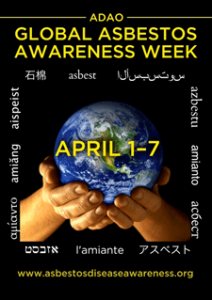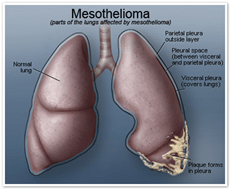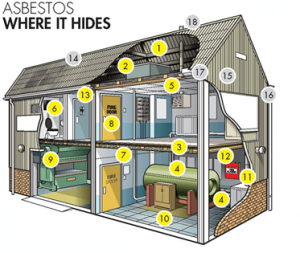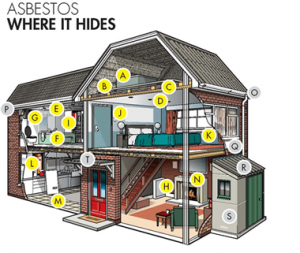Help reduce 300 deaths a day worldwide
This year, Global Asbestos Awareness Week will run from the 1st – 7th April. Organised by the Asbestos Disease Awareness Organisation (ADAO), the campaign aims to educate every country around the world about the effects of mining and working with asbestos.
The UK is one of 55 countries to have banned the use of asbestos – a known carcinogen – but many workers still have to work with it to remove/maintain it.
The campaign aims to highlight that 300 deaths a day occur around the world due to an asbestos-related disease, and that these deaths could be prevented.
Read this week’s article to find out how you can best protect your staff from this deadly substance.
This week’s recent HSE cases are firstly 2 that concern asbestos and another regarding machinery accident
- Crane operator Jonathan Cloke, 37, died after falling from the crane as it collapsed. It fell on to Michael Alexa, 23, a member of the public, and also killed him
- The twenty-four year old worker tripped and fell through a skylight at least four metres to the concrete floor. He suffered a broken right arm and elbow and heavy bruising.
As ever, if you have a subject that you would like us to cover one week, please contact us by phone 01458 253682, email or via our Facebook page or by Twitter.
Asbestos Awareness Week
Help reduce 300 deaths a day worldwide
The Asbestos Disease Awareness Organization (ADAO) continues its worldwide campaign to eliminate asbestos with Global Asbestos Awareness Week (GAAW) 1- 7 April, 2016.
GAAW is intended to raise awareness of asbestos and educate communities to prevent asbestos-related disease in the hope that more and more countries will ban its use. It is a known fact that asbestos is still mined, imported and used in both developing and developed countries around the world despite being confirmed as a human carcinogen. The devastating health issues and diseases caused from exposure to asbestos represent a significant cost to society and an unbelievably painful experience for the individuals and families affected.
The World Health Organization (WHO) estimates that 107,000 workers around the world will die every year of an asbestos-related disease, equating to 300 deaths per day. Only 55 countries have banned asbestos and therefore workers are still being exposed to this daily, with potentially life threatening consequences.
Why is asbestos dangerous?
Asbestos still kills around 5000 workers in the UK each year, this is more than the number of people killed on the road.
Around 20 tradesman die each week as a result of past exposure
However, asbestos is not just a problem of the past. It can be present today in any building built or refurbished before the year 2000.
When materials that contain asbestos are disturbed or damaged, fibres are released into the air. When these fibres are inhaled they can cause serious diseases. These diseases will not affect you immediately; they often take a long time to develop, but once diagnosed, it is often too late to do anything. This is why it is important that you protect yourself now.
Asbestos can cause the following fatal and serious diseases:
Mesothelioma
Mesothelioma is a cancer which affects the lining of the lungs (pleura) and the lining surrounding the lower digestive tract (peritoneum). It is almost exclusively related to asbestos exposure and by the time it is diagnosed, it is almost always fatal.
Asbestos-related lung cancer
Asbestos-related lung cancer is the same as (looks the same as) lung cancer caused by smoking and other causes. It is estimated that there is around one lung cancer for every mesothelioma death.
Asbestosis
Asbestosis is a serious scarring condition of the lung that normally occurs after heavy exposure to asbestos over many years. This condition can cause progressive shortness of breath, and in severe cases can be fatal.
Pleural thickening
Pleural thickening is generally a problem that happens after heavy asbestos exposure. The lining of the lung (pleura) thickens and swells. If this gets worse, the lung itself can be squeezed, and can cause shortness of breath and discomfort in the chest.
Where can you find asbestos?
Asbestos can be found in any industrial or residential building built or refurbished before the year 2000. It is in many of the common materials used in the building trade that you may come across during your work.
In Industrial Buildings

Inside
- Sprayed coatings on ceilings, walls, beams and columns
- Asbestos cement water tank
- Loose fill insulation
- Lagging on boilers and pipes
- AIB ceiling tiles
- Toilet seat and cistern
- AIB partition walls
- AIB panels in fire doors
- Asbestos rope seals, gaskets and paper
- Vinyl floor tiles
- AIB around boilers
- Textiles eg fire blankets
- Textured decorating coatings on walls and ceilings eg artex
Outside
- Asbestos cement roof
- Asbestos cement panels
- Asbestos cement gutters and downpipes
- Soffits – AIB or asbestos cement
- Asbestos cement flue
AIB = Asbestos Insulating Board
In Residential Buildings
Inside
- Asbestos cement Water tank

- Pipe lagging
- Loose fill insulation
- Textured decorative coating eg artex
- AIB ceiling tiles
- AIB bath panel
- Toilet seat and cistern
- AIB behind fuse box
- AIB airing cupboard and/or sprayed insulation coating boiler
- AIB partition wall
- AIB interior window panel
- AIB around boiler
- Vinyl floor tiles
- AIB behind fire
Outside
- gutters andAsbestos cement downpipes
- Soffits – AIB or asbestos cement
- AIB exterior window panel
- Asbestos cement roof
- Asbestos cement panels
- Roofing felt
AIB = Asbestos Insulating Board
So what is the risk?
Asbestos fibres are tiny and can be released into the air when asbestos-containing materials (ACMs) are damaged or disturbed.
They can subsequently then be breathed in by people in the area. Asbestos-related diseases can be at best debilitating and at worst fatal. They range from asbestosis (scarring of the lungs) through to mesothelioma, a cancer affecting the lining of the lungs. These conditions are painful and there is no cure.
When am I most at risk?
You are most at risk when:
- the building you are working on was built before the year 2000
- you are working on an unfamiliar site
- asbestos-containing materials were not identified before the job was started
- asbestos-containing materials were identified but this information was not passed on by the people in charge to the people doing the work
- you haven’t done a risk assessment
- you don’t know how to recognise and work safely with asbestos
- you have not had appropriate information, instruction and training
- you know how to work safely with asbestos, but you choose to put yourself at risk by not following proper precautions, perhaps to save time or because no one else is following proper procedures
Remember
- you can’t see or smell asbestos fibres in the air
- the effects of being exposed to asbestos take many years to show up – avoid breathing it in now
- people who smoke and are also exposed to asbestos fibres are at a much greater risk of developing lung cancer
- asbestos is only a danger when fibres are made airborne and breathed in
- as long as the asbestos is in good condition and it is located somewhere where it can’t be easily damaged then it shouldn’t be a risk to you
Protect Your Staff from Harmful Asbestos Fibres: 5 Top Tips
- Undertake a risk assessment before starting work to identify if your work is likely to disturb any asbestos. Ask the owner of the building for any information on the location of ACMs, and always work on the assumption that asbestos could be present until proven otherwise.
- Asbestos could be found in any building in the UK which was built or refurbished before the year 2000, and is found in many materials such as lagging, insulation, asbestos cement, floor and ceiling tiles and sprayed coatings. Make sure you check asbestos surveys and asbestos management plans before undertaking any work on the fabric of a building.
- Train staff in asbestos awareness, so that they can learn to recognise it when they come across it, and to know what precautions to take if they think they have disturbed it by mistake.
- If asbestos is in a good condition, it can be safer to leave it and maintain it rather than remove it. For some ACMs, you can buy special sealants to help keep the fibres contained.
- If workers are likely to be exposed to asbestos fibres, you must provide them with suitable personal protective equipment. Opt for disposable overalls and dispose of these as asbestos waste. Never allow employees to take these items home for washing.
Asbestos awareness Training
Information, instruction and training for asbestos awareness is intended to give workers and supervisors the information they need to avoid work that may disturb asbestos during any normal work which could disturb the fabric of a building, or other item which might contain asbestos. It will not prepare workers, or self-employed contractors, to carry out work with asbestos-containing materials. If a worker is planning to carry out work that will disturb ACMs, further information, instruction and training will be needed.
The Wilkins Safety Group are running an Asbestos Awareness Course on 12th April 2016 – See details under courses
Help spread the word this April about the devastating effects of asbestos on human health, and inform your workers about how and why they need to protect themselves and others.
Training

We shall be running new courses again in 2016 and the dates and details of forthcoming courses will be published here each week.
But remember we are still available for running “In House” courses and we have now also added a new training service for our customers.
Site Manager Safety Training Scheme
(Part of Construction Skills “Site Safety Plus” Suite of Courses)
We have formed an association with a local company TQ Excel who are one of the UK’s leading providers of accredited training to the highways sector of the construction industry.
AS a result of this we can now offer the SMSTS (Site Management Safety Training Scheme)
The Site Management Safety Training Scheme forms part of the Construction Skills (CITB) Site Safety Plus range of courses which are highly regarded within the construction industry.
The 5 day training course is aimed at site managers wishing to develop a more in depth legal, moral and social understanding of their role and also teaches delegates how to manage on-site health and safety in accordance with current legislation.
We also offer the 2 day SSSTS Training Course (Site Supervisor Safety Training Scheme) which is a 2 day course aimed at those with on-site supervisory responsibilities.
We also can now offer NRSWA courses.
These qualifications are for those involved in the Excavation and Re-instatement of the highway and are specified under the New Roads and Street Works Act 1991. They are a legal requirement for “statutory undertakers” (i.e. Utility Contractors) and for those working under “section 50 licenses” (Drainage works etc).
Where works are subject to the Act there must be a minimum of 1 qualified operative on every site that is qualified for the operations being carried out and there must be a Supervisor available to visit the site at least on a daily basis.
The qualifications are also often specified by client organisations and local authorities when appointing contractors for works involving excavation or reinstatement of the highway for other purposes.
The first of our courses are:
Liability for Accidents and Ill Health at Work
Seminar Objective – Training /CPD Certificate issued
This one day course looks at your liability, as Company Owner, Director, or Manager. The course will look at a number of case studies and explain the legal requirements of the Employer, Managers, and your Safety Adviser
Seminar Outline
- Legal framework and legislation (Criminal and civil liabilities)
- Roles and responsibilities of Directors, senior management team and the H&S Advisers
- An HSE Investigation
- Criminal Law – Who’s Liable
- The New powers of the Courts
- Compensation – Who’s Liable
- Corporate Manslaughter – The key things to know
- When it is the employee’s fault
- How to reduce your liability as an employer
- How you could be personally liable
- Successful cases against Health & Safety Advisers
Benefits of Attending
- By attending this course you will understand your liability regarding Health & Safety at work. And what you need to do to protect yourself and your business.
- How the Authorities investigate incidents and how the courts fine you.
Course Duration:
1 day
COURSE REF DATE(s) LOCATION
LIAB 1601 Monday 4th April 2016 Taunton Racecourse, TA3 7BL
Fee: £150 to include Course notes, mid-morning & afternoon refreshments, Finger buffet lunch, CPD Certificate (Fee subject to VAT)
Re-qualification First Aid at Work
This First Aid at Work Refresher course is designed for anyone who has previously completed the 3 day First Aid at Work qualification and needs to renew their skill-set and certification. This refresher lasts 2 days and secures the delegates’ qualification for a further 3 years before the course will need to be retaken.
Updated to cover the control of catastrophic bleeding
SYLLABUS
- Course introduction.
- Legal compliance.
- Managing incidents.
- Examining a casualty.
- Conscious/unconscious casualties.
- Treating a casualty.
- Further emergency action.
- General common illnesses.
- Basic life support.
- First aid kits/equipment.
- Recording/reporting injuries.
Course Duration: 2 Days
COURSE REF DATE(s) LOCATION
WSG. RFAW. 1601 14th & 15th April 2016 6 Amor Place, Taunton, Somerset TA1 4SG
The all-inclusive rate of £165.00 + vat per delegate will be payable at the time of booking.
Your staff can attend three months before the expiry date on their certificate and still retain the month of expiry on their new certificate.
They must renew no later than 28 days after their expiry date.
CDM Regulations 2015 – For the Smaller Builder
Course Objective
The Construction (Design and Management) Regulations 2015 (CDM 2015) come into force on the 6th of April 2015, and will apply to all construction projects in the UK incl. Domestic projects
This CDM 2015 awareness training course has been developed to provide smaller builders and tradesmen, especially those who haven’t dealt with CDM before, with an understanding of their role and responsibilities under CDM 2015.
Seminar Outline
- Overview of the Industry accident rate
- The Legal framework
- Enforcement
- Risk Assessment
- CDM 2015 and the duty holders: Client, PD, Designers
- Principal Contractors duties
- Contractors duties
- Construction Phase Plan
- Site Safety Management
- Benefits of Attending
This course give an overview of the requirements for smaller builders and domestic clients and how the regulations apply to all construction projects from minor repairs and decorating works through to building a new house for a domestic client.
Course Duration: 1/2 day 09:00 Hrs to 12:30 Hrs
COURSE REF DATE(s) LOCATION
CDM-SB-1601 Tuesday 12th April 2016 Taunton Racecourse, TA3 7BL
Fee: £80 to include Course notes, Coffee on arrival & mid-morning refreshments and a Certificate of Training (Fee subject to VAT)
A free lunch is also included if you book this course along with the Asbestos Awareness course below.
ASBESTOS AWARENESS – Half-Day Course
Course Objective – Training /CPD Certificate issued 
Asbestos awareness training is essential for employees whose work holds the potential to expose them to asbestos. The Control of Asbestos Regulations 2012 puts a requirement on employers to ensure that their staff have undergone suitable asbestos awareness training so that they are aware of the potential dangers they may face and also the procedures they must follow in the event they are working in the vicinity of asbestos containing materials (ACMs)
Who Is This Course Suitable For?
The main groups of workers that are deemed to be at risk from asbestos exposure and therefore the groups’ most requiring asbestos awareness training are as follows:
- General Maintenance Staff.
- Electricians, Plumbers & Gas Fitters. Painters & Decorators.
- Construction & Demolition Workers. Joiners and Plasterers.

- Computing & Telecommunications Engineers.
- Heating & Ventilation Engineers.
- Roofers.
- Architects & Building Surveyors
- Fire & Burglar Alarm Installers
Syllabus
- Asbestos- a history of use
- What is Asbestos
- Amosite (Brown) – Chrysotile (White) – Crocidolite (Blue)
- Asbestos Containing Product Examples
- Asbestos Properties and the hidden legacy of asbestos

- Control of Asbestos Regs and Requirements
- Exactly who is at risk
- Action to take on discovery and Survey and Recording
Course Duration: ½ day – 13:30 Hrs to 16:30Hrs
COURSE REF DATE(s) LOCATION
ASBESTA 1601 Tuesday 12th April 2016 Taunton Racecourse, TA3 7BL
Fee: £65 to include Course notes, Coffee/Tea on arrival & mid-morning refreshments, CPD Certificate of Training (Fee subject to VAT)
CDM Regulations 2015 – An Awareness Course
Course Objective Training /CPD and APS Certificates
The Construction (Design and Management) Regulations 2015 (CDM 2015) come into force on the 6th of April 2015, and will apply to all construction projects in the UK incl. Domestic projects.
This CDM 2015 awareness training course has been developed to provide all duty holders with an understanding of their role and responsibilities under CDM 2015.
Seminar Outline
- Introduction to CDM 2015
- Notification
- Client Duties and Domestic Clients
- Principal Designer Duties
- Principal Contractor Duties
- Designer Duties
- Contractor Duties
- CDM Documentation
- Benefits of Attending
These courses give an overview of the requirements for Clients, Principal Designers, Principal Contractors, Contractors, Designers and Workers, and how the regulations apply to construction projects.
An individual who successfully completes this CDM2015 Awareness Course may claim points towards membership of the Association for Project Safety – APS
Course Duration: 1 day
COURSE REF DATE(s) LOCATION
CDM2015 1601 Monday 18th April 2016 Taunton Racecourse, TA3 7BL
Fee: £170 to include Course notes, mid-morning & afternoon refreshments, Finger buffet lunch, a Certificate of Training and APS Certificate (Fee subject to VAT)
If you have any questions about these courses or any other training or would like us to run a particular course for you, call Jon Wilkins of the Wilkins Safety Group on 01458 253682 or email him.
Your business is safer in our hands
